.
N - O - P - Q - R - S - T - U - V - W - X - Y - Z
Caltrops c. 330 BC
An early example of a reinforcing obstacle intended for use on a battlefield, as opposed to during a siege, occurred around 330 BC during the time of Alexander the Great. The Greeks were aware of a new invention called caltrops, which could be scattered in front of their battle lines to disrupt the terrifying attacks of the massive Persian war elephants. Caltrops are devices with four metal points arranged so that when three are on the ground, the fourth projects upward as a hazard to animal hooves or tires. Caltrops were used as recently as the Korean Conflict, when the U.S. Air Force dropped them on Chinese convoys to puncture tires. The U.S. also dropped them on the Ho Chi Minh trail during the Vietnam War. Major William C. Schneck The Origins of Military Mines
Another known example is the use of Caltrops by James Bond thrown from his BWM car "automated caltrops dispenser" in the 1997 Film Tomorrow Never Dies.
Armies developed anti-elephant weapons. In attack, the aim was to try to surround individual beasts, threatening them from the flank and rear. For this, special weapons might be devised, such as the scimitars and axes used by Alexander. Caesar used slingers who could aim at the mahout as well as the elephant. During the Sassanid Wars cataphracts (men armored with iron spikes which prevented the elephants from seizing them with their trunks) were used. The Romans were said to have deployed iron-pointed beams mounted on wagons against Pyrrhus. The ingenious Romans also used chariots drawn by armored horses, an arrow-firing catapult mounted on a vehicle drawn by horses or mules, and fire carts. Polyperchon used nail studded frames as moveable barriers at Megalopolis and Ptolemy laid an iron-spiked minefield at Gaza. . (But also pigs were used against elephants!) ..when Antigonas Gonatas was besieging Megara, the Megarians succeeded in routing the besiegers’ elephants by dousing pigs in oil and igniting them and then turning them loose against the elephants. Emory Rowland Military Use of Elephants in the Greek and Roman Period
H. H. Scullard, The Elephant in the Greek and Roman World, New York, Cornell University Press, 1974.
W. W. Tarn, Hellenistic Military and Naval Developments, New York, Biblo and Tannen, 1966.
Camera Obscura
According to some reports on the net Archimedes used a box with a little hole on one side and a piece of papyrus on the other. The image was passing through the hole and was shaping an image on the papyrus. I do not have found more details and references for this story. The earliest known written evidence of a camera obscura can be found in Aristotle's documentation of a device in 350-330 BC in Problemata" (Patti, 1993). Aristotle's apparatus contained a dark chamber that had a single small hole to allow for sunlight to enter. With this device, he made observations of the sun. He noted that no matter what shape the hole was, it would still display the sun correctly as a round object. Another observation that he made was that when the distance between the aperture (the tiny hole) and the surface with the image increased, the image would become amplified. (Who said that Aristotle did not like experiments???) Although no one is perfectly sure, many attribute the invention of the camera obscura to Aristotle.
The first casual reference [to the Camera Obscura] is by Aristotle (Problems, ca 330 BC), who questions how the sun can make a circular image when it shines through a square hole. Euclid's Optics (ca 300 BC), presupposes the camera obscura as a demonstration that light travels in straight lines. Egnacio Danti in commentary on his translation of Euclid's Optica (1573), adds a description of the camera obscura... Aristotle (384 - 322 B.C.) observed the crescent shape of the partially eclipsed sun projected on the ground through the holes of a strainer, and the gaps between the leaves of a tree. He also noticed that the smaller the hole, the sharper the image. In modern cameras, this is analogous to the diaphragm. http://www.acmi.net.au/AIC/CAMERA_OBSCURA.html
Catalog of Books (database)
Callimachus of Cyrene, a scholar and librarian at the Library of Alexandria, created about 245 BC for the first time a catalog of Greek literature covering 120000 books, called the Pinakes or Tables.
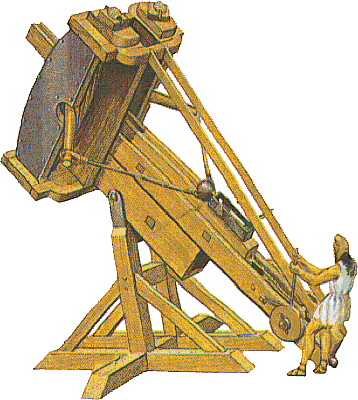
The Greek Palintonon weapon
The catapult is a device that hurls heavy objects or arrows over a large distance. It was invented in ancient Greece in 399 BC by Dionysius the Elder of Syracuse (at the same time we have the Gastraphetes). Probably earlier the Assyrians used missile devices (700 BC ?) and this idea has been passed to the Persians, the Phoenicians and later to the Greeks but the Greeks developed the first effective versions. The Romans later added wheels to the catapult to make it more maneuverable. Two major catapults evolved from Dionysius's invention: the double-armed machine, or ballista, used for shooting arrows, and the single-armed catapult designed for hurling large objects. The catapult (also called the ballista) was a major weapon of warfare for well over a thousand years. Catapults could throw stones weighing as much as 350 pounds for distances greater than 300 feet. The most complex catapult was probably the Repeating Catapult or Polybolon: See also: Ancient Greek Artillery Technology , Catapults (Scientific American) E.W. Marsden, Greek and Roman Artillery. Historical Development, 48-64. (PDF File)
The Defense of Syracuse by Archimedes, Polybius

http://home.t-online.de/home/d.baatz/catgastr.htm (Offline now)
Chewing Gum
Long before the Americans for centuries the ancient Greeks chewed mastic gum mastic or mastiche pronounced “mas-tee-ka”. This is the resin obtained from the bark of the mastic tree, a shrublike tree found mainly in Greece and Turkey. Grecian women especially favored chewing mastic gum to clean their teeth and sweeten their breath. Modern chewing gum had its beginning in the late 1860s when chicle was brought to the United States and tried as a chewing gum ingredient. Chicle comes from the milky juice of the sapodilla tree, which grows in the tropical rain forests of Central America. This tree is found mainly in those parts of Mexico, Guatemala and Belize that lie within the Yucatan Peninsula.
Mastic Is More Than An Antibacterial
The invention of formal city planning was attributed to Hippodamos of Miletus, who was born at the very end of the 6th century BC. Hippodamos helped to design the new harbor town of Piraeus, which served as a commercial port for Athens further inland. Hippodamus' name is frequently associated with other orthogonally planned towns, such as Olynthus, Priene, and Miletus. His direct involvement in these cases remains unproven, but his name remains permanently associated with this type of plan that we call Hippodamian.
COIN automat
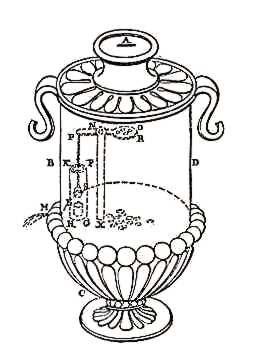
From: A History of Science by Henry Smith Williams:
..There is one mechanism described by Heron which was a most explicit anticipation of a device, which presumably soon went out of use, and which was not reinvented until towards the close of the nineteenth century. This was a device which has become familiar in recent times as the penny-in-the-slot machine. When towards the close of the nineteenth century some inventive craftsman hit upon the idea of an automatic machine to supply candy, a box of cigarettes, or a whiff of perfumery, he may or may not have borrowed his idea from the slot-machine of Hero; but in any event, instead of being an innovator he was really two thousand years behind the times, for the slot-machine of Hero is the precise prototype of these modern ones. The particular function which the mechanism of Hero was destined to fulfill was the distribution of a jet of water, presumably used for sacramental purposes, which was given out automatically when a five- drachma coin was dropped into the slot at the top of the machine. The internal mechanism of the machine was simple enough, consisting merely of a lever operating a valve which was opened by the weight of the coin dropping on the little shelf at the end of the lever, and which closed again when the coin slid off the shelf.

A similar but more complex automaton, the water spending device of Philon of Byzantium that also provides (here by a hand) a piece used like a soap (red spheres) for washing the hands (image colored version from Carra de Vaux ).
Compound Pulley
Trispaston, consisting of a combination of wheels and axles. According to Tzetzes and Oribasius it could draw the most stupendous weights.
By Archimedes:
[Archimedes] had stated [in a letter to King Hieron] that given the force, any given weight might be moved, and even boasted, we are told, relying on the strength of demonstration, that if there were another earth, by going into it he could remove this. Hiero being struck with amazement at this, and entreating him to make good this problem by actual experiment, and show some great weight moved by a small engine, he fixed accordingly upon a ship (Syracusia) of burden out of the king's arsenal, which could not be drawn out of the dock without great labour and many men; and, loading her with many passengers and a full freight, sitting himself the while far off, with no great endeavour, but only holding the head of the pulley in his hand and drawing the cords by degrees, he drew the ship in a straight line, as smoothly and evenly as if she had been in the sea. Plutarch
Syracusia the giant ship designed by Archimedes
Computing device (Planetarium)
Used to predict the position of planets. The most sophisticated device of the ancient world is the Antikythera device
Copy Machine ? (See Pointing Machine)
Cranes (geranos)
Archaeologists assume that cranes were used in Greece since 900 BC (although there is no direct proof). After a recent discovery of a 2.3 ton and 2900 years old sarcophagus in Corinth an archaeologist (Guy Sanders) said: "To lower the sarcophagus into place in a controlled movement ... requires some kind of temporary superstructure over the grounds so they can control the vertical movement of the stone”.
- Construction Crane
for the construction of the harbour of Amathus in Cyprus (for the Demetrios Poliorcetes fleet)
or temples (according to Vitruvius Greek Cranes could lift 6 tons, The columns were build by parts, so-called column drums, with a weight each more than 1 ton) ( Cut, Transport and Construction of the Greek Temples )

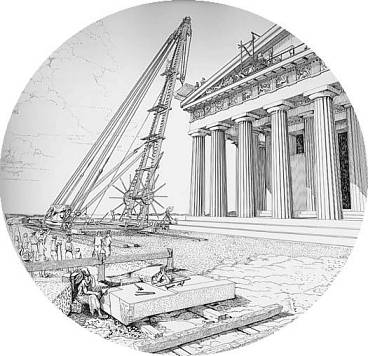
Positioning of acroteria on the Parthenon. Manolis Korres, From Pentelicon to the Parthenon, 1995 Athens.
See also: life-size replica of a Roman crane modern Xanten, Archaeological Park. Credits: Barbara McManus, 1988
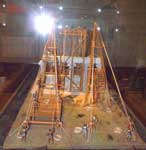
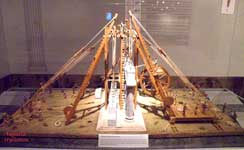
“Iron Hand” of Archimedes”
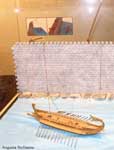

Iron Hand, Archimedes, The stone throwing machine ,
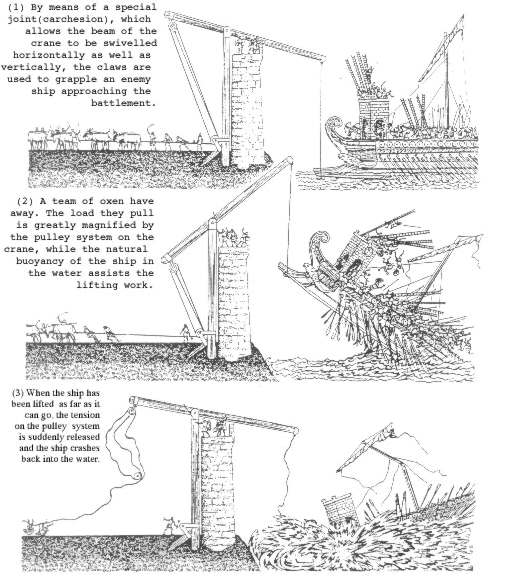
(Archimedes Claw, Military Technology p 225)
Invented by Archimedes used to move large ships but also to destroy these as Plutarch describes in Marcellus Chapter XV: "... when Archimedes began to ply his engines, he at once shot against the land forces all sorts of missile weapons, and immense masses of stone that came down with incredible noise and violence; against which no man could stand; for they knocked down those upon whom they fell in heaps, breaking all their ranks and files. In the meantime huge poles thrust out from the walls over the ships and sunk some by great weights which they let down from on high upon them; others they lifted up into the air by an iron hand or beak like a crane's beak and, when they had drawn them up by the prow, and set them on end upon the poop, they plunged them to the bottom of the sea; or else the ships, drawn by engines within, and whirled about, were dashed against steep rocks that stood jutting out under the walls, with great destruction of the soldiers that were aboard hem. A ship was frequently lifted up to a great height in the air (a dreadful thing to behold), and was rolled to and fro, and kept swinging, until the mariners were all thrown out, when at length it was dashed against the rocks, or let fall." Plutarch, Marcellus
- Cranes for Theaters (Aeorema)
A hidden crane (so-called mechane (machine)) used in the Greek theater. Actors connected with a cable were lifted in order to simulate for example a flying god (Deus ex machina or "god from the machine" now describing an unexpected solution for some in a hopeless situation)
Theatrical Devices
(Other devices in theater the Ekkyklema )
- Other cranes
Diognetus was a Rhodian architect, who, to his honour, on account of his great skill, had an annual fixed salary. At that period, an architect of Aradus, whose name was Callias, came to Rhodes, obtained an audience, and exhibited a model of a wall, whereon was a revolving crane, by means whereof he could suspend an Helepolis near the spot, and swing it within the walls. The wondering Rhodians, when they saw it, took away the salary from Diognetus, and conferred it on Callias. Marcus Vitruvius Pollio: de Architectura
A lifting device was used in the the so called Oracle of the Dead (Nekromanteio or Nekyomanteio) close to the village Mesopotamos / Parga in Epirus. People asked the dead for solutions of their problems. Priests were involved who prepared each person for the encounter with the dead by asking questions. The person were prepared for the encounter also with a specific diet that had a narcotic effect.The priests used a crane like in the theaters to fly around in the dark cave immitating the dead souls and since they had enough information they could provide some answers. The persons in a religious ecstasy believed that the encounter was real.
Chris Rorres, Symposium on Extraordinary Machines and Structures in Antiquity August 19-24, 2001 - Olympia, Greece : A Formidable War Machine: Construction and Operation of Archimedes’ Iron Hand (PDF File)
See Archimedes Claw with Animations and Illustrations
A - B - C - D - E - F - G - H - I- J - K - L - M -
N - O - P - Q - R - S - T - U - V - W - X - Y - Z
| Ancient Greece
Science, Technology , Medicine , Warfare, , Biographies , Life , Cities/Places/Maps , Arts , Literature , Philosophy ,Olympics, Mythology , History , Images Medieval Greece / Byzantine Empire Science, Technology, Arts, , Warfare , Literature, Biographies, Icons, History Modern Greece Cities, Islands, Regions, Fauna/Flora ,Biographies , History , Warfare, Science/Technology, Literature, Music , Arts , Film/Actors , Sport , Fashion --- |

